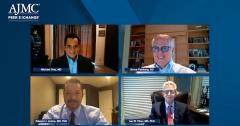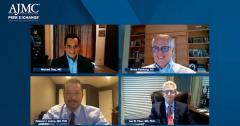
Future of Outpatient CAR T Administration
Episodes in this series

The evolving treatment landscape of CAR T therapy for the treatment of R/R NHL in an outpatient community setting.
Transcript:
Bruce Feinberg, DO: Ian, time for closing thoughts. Time for the crystal ball. In 3 years, how do you think the landscape changes? Are there additional products in the market? Which ones? How much movement will there be to outpatient administration of the product, even at centers like yours? And where UPenn [Abramson Cancer Center] isn’t the albatross, but everybody is doing the infusion outpatient and bringing back whatever that number may be—40%, 60%—to get the more profound toxicity? Where do you think we are in 3 years?
Ian W. Flinn, MD, PhD: In 3 years, we’ll definitely have more products. Everyone assumes that the liso-cel will get approved. That’s a great thing because it’s good to have a choice between 1 manufacturer and another. The patient gets better service, we get better service, and we have a choice and are able to prescribe it for each patient. We’re going to have more diseases being treated. We’re going to have a product for multiple myeloma that will be approved soon, and we’re going to be treating more and more diseases.
I can’t imagine that we’re not going to be doing more of this as an outpatient. We could do stem cell transplants as an outpatient. Autologous or allogeneic transplants can be done as an outpatient. I’m sure this will be done, as Ed was pointing out, but we have to be prepared to be on the receiving end, to receive these patients if they develop adverse events. The number of patients is going to be expanded, the safety is going to get better, the number of products that are going to be coming into the market is going to get better with each passing year, and ultimately, outcomes are going to improve for our patients.
Bruce Feinberg, DO: Ed, crystal ball, but I’ll let you go to 5 years. You can also address lines of therapy.
Edward J. Licitra, MD, PhD: These are highly innovative treatments that we haven’t scratched the surface. Moving forward, they will move up in lines of therapy; there’s no doubt. The bottleneck is going to be what the access looks like. The patients are going to require these treatments in the next 3 to 5 years to the standard of care and early lines of therapy. For that reason, it’s critically important that there’s a focus in terms of building out community-based care-delivery sites in strategic locations that can offer patients this option close to home. Because no matter what, the coordination of care is still complex. If we don’t put the proper procedures in place and deliver this care close to a patient’s home, my fear is that patients won’t receive treatments that they could benefit from.
Looking out to 5 years, there will be an increased demand for CAR [chimeric antigen receptor] T cells. We are going to have to develop strategically located sites that have the capability of delivering CAR T cells in a safe way, and ultimately we have to solve an access problem because there may be an access problem down the road. If we don’t put the proper infrastructure in place to deliver CAR T cells at scale, then patients may not get the innovative therapies that they deserve.
Bruce Feinberg, DO: Michael, this is the easy 1. I just want to know, 3 years into that crystal ball, where is Florida Cancer [Specialists]? Beyond Florida Cancer, it’s American Oncology [Networks]’s CAR T program.
Michael Diaz, MD: About 3 years from now, I would say that Florida Cancer Specialists will have at least 1 well-developed CAR T-cell site. We’ll probably be planning a second or third if they have not already been started. We’re just going to see the indications evolve and increase, the products increase, the number of patients who can benefit from these therapies increase as it gets moved up to a higher line of therapy—a second or third line of therapy. One of the challenges we’re going to have is to make sure we’re identifying the right patients for these therapies because there is an associated economic cost. We want to make sure we’re delivering the appropriate quality and value to the patients at the same time. Just because you have a condition and you have a CAR T-cell therapy, it may not necessarily mean that it’s going to be the best option for you. You’re going to see a lot of evolution of studies looking at the right patient population as we evolve as well.
Bruce Feinberg, DO: Gentlemen, that was great. Thank you to those who have been watching this presentation. I’m Bruce Feinberg from Cardinal Health. With me today has been Dr Ian Flinn, director of the blood cancer research program at Tennessee Oncology; Dr Ed Licitra, a medical oncologist, the CEO of Titan Health Partners, and a board member of Community Oncology Alliance; and Dr Michael Diaz, a board member at and the director of patient advocacy for Florida Cancer Specialists, and the president of Community Oncology Alliance.
Today we had a chance to discuss, in depth, the potential future of CAR T administration in the outpatient setting. We hope you all enjoyed it, learned something, and maybe even were a bit entertained. With that, I’ll bid you all a good day. Thanks again, gentlemen.
Newsletter
Stay ahead of policy, cost, and value—subscribe to AJMC for expert insights at the intersection of clinical care and health economics.




































